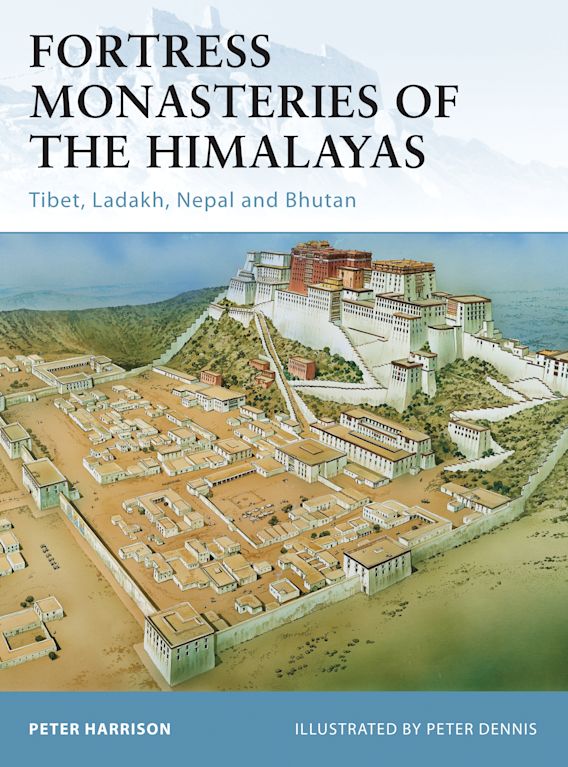 Fortress Monasteries of the Himalayas
Fortress Monasteries of the Himalayas

Il buddhismo è stato influente nei regni montani dell'Himalaya sin dal VII secolo d.C., in particolare nel Tibet, dove ha permeato tutti gli aspetti e i livelli della società fino al XX secolo. Dal IX secolo d.C. in poi, i governanti secolari del Tibet cercarono di estendere la loro influenza, e quella del buddhismo, in tutta la regione. A tal fine, furono costruite enormi fortificazioni in pietra e mattoni di fango, note come dzong, per dominare il paesaggio secolare, mentre massicci monasteri buddhisti dominavano quello religioso, entrambi seguendo uno stile molto specifico di architettura tibetana. È stato stimato che furono costruiti fino a 3.000 monasteri insieme a 200 dzong.
Le invasioni mongole dal XII secolo in poi esercitarono un'altra influenza, mentre i combattimenti intestini nel XVII secolo portarono ad una maggiore fortificazione dei monasteri e all'ascesa del Dalai Lama a capo di una teocrazia in Tibet, incentrata sul Palazzo del Potala a Lhasa - un vera fusione tra dzong secolare e monastero religioso.
Altrove nell'Himalaya influenzato dai tibetani, il del Ladakh resistette agli assalti sia dei musulmani che dei sikh e sviluppò uno stile di monastero-fortezza situato su picchi rocciosi per la difesa, questi spesso furono combinati con i palazzi fortificati dei governanti del Ladakh. Con la fondazione del Bhutan nel XVII secolo, furono creati ulteriori monasteri fortificati nel tentativo di proteggere l'indipendenza del nuovo stato dal Dalai Lama.
Queste fortificazioni sono sopravvissute in gran parte intatte fino ad oggi, poiché il controllo cinese sulla regione autonoma tibetana ha portato alla distruzione della stragrande maggioranza dei monasteri fortificati e degli dzong di quella particolare area.
Questo titolo ricrea le drammatiche e colorate fortificazioni create in questi regni montani e racconta la loro storia operativa attraverso le incursioni straniere, i conflitti religiosi e le guerre civili che ne costellano la storia, fino alla rivolta tibetana e alla fuga del Dalai Lama dal Palazzo del Potala nel 1959.
|
|
Buddhism has been influential in the mountain kingdoms of the Himalayas since the 7th century AD, most notably in the kingdom of Tibet where it permeated all aspects and levels of society until the 20th century. From the 9th-century AD onwards, the secular rulers of Tibet sought to extend their influence, and that of Buddhism, throughout the region. To this end, huge stone and mud-brick fortifications, known as dzongs, were constructed to dominate the secular landscape, while massive Buddhist monasteries dominated the religious - both following a very specific style of Tibetan architecture. It has been estimated that as many as 3,000 monasteries were built along with 200 dzongs.
Mongol invasions from the 12th century onwards provided another influence, while internecine fighting in the 17th century led to increased fortification of the monasteries and the rise of the Dalai Lama as the head of a theocracy in Tibet, centred on the Potala Palace in Lhasa - a true fusion between secular dzong and religious monastery.
Elsewhere in the Tibetan-influenced Himlayas the Buddhist Indian Kashmiri kingdom of Ladakh withstood assaults by both Muslims and Sikhs and developed a style of fortress monastery located on rocky peaks for defence, these often became combined with the fortified palaces of the rulers of Ladakh. With the foundation of Bhutan in the 17th century, further fortified monasteries were created in an effort to protect the new state's independence form the Dalai Lama.
These fortifications have survived largely intact through today, as Chinese control over the Tibetan Autonomous Region has led to the destruction of the vast majority of the fortified monasteries and dzongs of that particular area.
This title recreates the dramatic and colorful fortifications created in these mountain kingdoms, and recounts their operational history through the foreign incursions, religious conflicts and civil wars that litter their history, right through to the Tibetan uprising and flight of the Dalai Lama form the Potala Palace in 1959 |